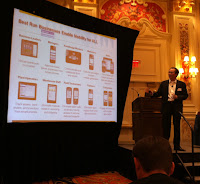Today we are fortunate to have a guest blogger from Dell, David Malmborg. David works with the
Dell Kace solution. He enjoys writing about technology, computers and saving money. Thanks David!
***
The need to consistently deliver reliable software and IT support to remote users for a large enterprise has become the rule rather than the exception in modern business. As staff and employees spread out across the country, or even into the international market, they still require access to the same applications and security that employees receive on-site.
There is a huge opportunity for enterprises to improve efficiencies and increase productivity by implementing mobile strategies and procedures, but only if all the devices and software are updated with the most current versions of the software and have the important security updates and patches. It has become critical for the IT team to have control over remote administration, software distributions, and installations in order to keep every department (and especially the mobile users) connected and up-to-date.
Problems to Avoid
As the number of personal and corporate smartphones, tablets, and laptops continue to go up, it can become extremely difficult for the enterprise to ensure that every mobile user has the ability to reach the information or applications they need to be truly effective. Technologies continue to change and applications are updated to keep pace, and this can lead to some costly problems for many organizations.
If these mobile assets are not meticulously tracked and managed, it won’t be long before the enterprise could start over-purchasing software licenses or find itself lacking the necessary assets when a user requires immediate access to something. All of these problems can end up costing the company a lot time and money.
A System for Software Deployment
Effective enterprise mobility requires that the IT department has the ability to track software resources, streamline the delivery system, and automate management. A software installation in-house was once handled manually, but since then companies have moved to a distribution system that is much faster and provides better tools for taking inventory and automating installations.
These systems, like the enterprise software deployment tools offered by Dell, have made it possible to create disc images and deploy them to every computer on the network. This also extends to remote locations and offices, and the same principles can be applied to the growing reliance on smartphones and tablets for mobile users.
Whether the company is updating the security features of an application or migrating to an entirely new operating system, the discovery, deployment and maintenance process can make the change more effective. The discovery phase can determine exactly what devices need access to the network, and what software is currently in use. The software installation can also be automated, if the right tools are employed. Finally, continued maintenance is about making sure that each of these devices are receiving the right updates and software to continue serving as an effective tool wherever they are used.
Guest blogger: David Malmborg
*************************************************************
Kevin Benedict, Independent Mobile Industry Analyst, Consultant and SAP Mentor Volunteer
Follow me on Twitter @krbenedict
Full Disclosure: I am an independent mobility analyst, consultant and blogger. I work with and have worked with many of the companies mentioned in my articles.




















